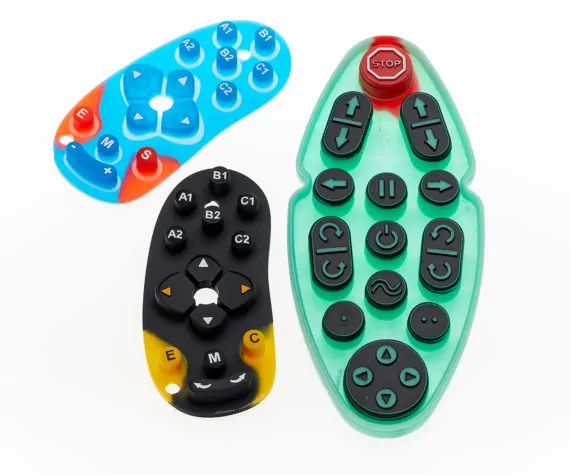Price critical parameters when designing silicone keypads

When designing a keypad it is important that you have an understanding of how the production costs of producing the keypad are calculated as this will have an impact on what features you can include.
Silicone keypads are typically produced using a compression moulding method in a high temperature 200T press. This method of production is slow compared to injection moulding as the cycle time can be up to 15 minutes per shot. Due to this lengthy cycle time it is important to have as many impressions in the tool as possible. For example a small keypad size of 50 x 50mm could have 49 impressions and produce 196 parts per hour but a larger keypad size of 100 x 150 would only have 6 impressions so only produce 24 parts per hour. This output is the main driver of price when producing keypads.
As well as output in moulding you should also be aware of set up costs. Set up costs are applied when producing small quantities, there are costs involved in preparing the silicone material, setting up the moulding press, printing and spraying. This means that if the quantity is low and you have extra operations such as prints and spray coatings then the unit cost for the keypad will be high.
When designing keypads it is often the case that multiple print colours are requested, this can enhance the value of the product but also adds to the cost, if the order quantities are high enough then printing is a small addition to the unit cost as is spray coating. If however backlighting is required through a process of laser etching the keypad or if the keypad needs epoxy resin tops then these extra operations are expensive and again will add increased cost to the parts if the quantities are not high.
On many keypads Carbon contact pills are used to create the switch connection between the keypad and the PCB. The carbon pills are assembled during the moulding process and do not have any major effect of the unit cost but do help with reducing the overall assembly cost as much cheaper than using mechanical switches.
An example of reducing costs, when several mouldings are required it is sometimes possible to have several designs in the same mould tool rather than having separate tools, this keeps the initial tooling costs low and can save several thousands of pounds.
It is difficult to give clear guide lines on how to reduce costs. The easiest process to follow is to design the keypad to suit your requirements and then look at the alternative methods available if the costs are too high. This way of developing the project often allows the manufacturer of the keypad to suggest alternatives that may not before have been considered without sacrificing design and quality.
The most important issue to remember is not to compromise your design where possible as the keypad is often the most important item in your instrument and can add value far in excess of the cost in making it.